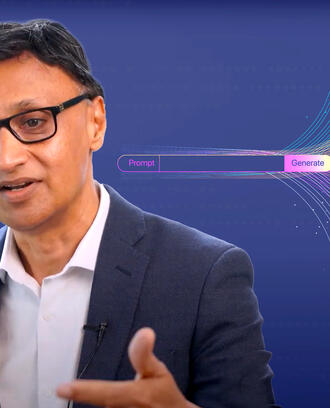Credit: Kaewta Suphan / iStock
AI agents, tech circularity: What’s ahead for platforms in 2026
What you’ll learn:
Experts outlined four emerging trends that show where platforms are heading next:
- It’s time to adapt platforms for agentic AI. A new generation of autonomous “agents” can already buy, sell, and negotiate on behalf of their users — a shift that could transform how digital markets operate.
- AI can accelerate technical debt. As firms experiment with AI tools that write code, companies are discovering a hidden cost: flawed or poorly integrated code that can make systems harder to maintain and more expensive to fix.
- The “AI stack” — the hardware and software used to build, train, and run AI models — is becoming tightly integrated and increasingly controlled by a handful of powerful companies. This concentration risks leaving most firms dependent on a few providers that are difficult to replace.
- Platform strategies, long focused on digital services, are beginning to extend into the physical world by helping companies recover, resell, and reuse hardware as part of a broader circular economy.
Digital platforms have already changed how value is created and exchanged. Their next wave — spanning physical assets, artificial intelligence, and automation — promises new efficiencies but also new risks.
At the 2025 MIT Platform Strategy Summit, hosted by the MIT Initiative on the Digital Economy, experts highlighted four emerging trends that together offer a snapshot of where platforms are heading next.
Read the 2025 Platform Strategy Summit report
Platforms adapt for agentic AI
AI is now being programmed to act on its own. A new generation of autonomous “agents” can already buy, sell, and negotiate on behalf of their users — a shift that could transform how digital markets operate.
“You are going to launch a marketplace, you’re going to have to onboard and get critical mass for agents. You’re going to have to design interfaces for agents,” said Marshall Van Alstyne, SM ’91, PhD ’98. “You’re going to have to create value and take value with agents. You’re going to have to sell to agents.”
Van Alstyne, a digital fellow at the MIT IDE and a Boston University professor, said these agents may soon make routine decisions without human involvement. This raises new questions about governance and oversight.
“This leads you to a learning-authority dilemma,” he said. “What happens when agent decision ability exceeds its formal authority?”
To prepare, Van Alstyne said, companies will need to adapt their platforms for AI interaction — creating interfaces agents can use, setting rules to manage agents’ behavior, and determining which decisions to automate and which to keep under human control.
The hidden costs of AI become clearer
Generative AI is helping companies work faster and link data from different systems more easily, but it is also creating new kinds of technical problems.
As firms experiment with AI tools that write code, for example, early studies are reporting big productivity gains. In reality, said Geoffrey Parker, SM ’93, PhD ’98, some of the world’s largest companies are discovering a hidden cost: piles of AI-generated code that does not work well in complex systems. Parker called this “turbocharged technical debt.”
Parker, a Dartmouth College professor and digital fellow at the MIT IDE, explained that this buildup of flawed or poorly integrated code can make systems harder to maintain and more expensive to fix over time.
“The code assistance is certainly here,” he said, drawing on his recent research, which was published in MIT Sloan Management Review. “It’s valuable, but the tech debt is actually a strategic risk and could be really expensive, especially for incumbent organizations.”
The AI stack becomes increasingly concentrated
The “AI stack” — the hardware and software used to build, train, and run AI models — is becoming tightly integrated and increasingly controlled by a handful of powerful companies. This concentration risks leaving most firms dependent on a few providers that are difficult to replace, according to Lynn Wu, PhD ’11, an associate professor at the University of Pennsylvania.
Wu noted that companies such as Google, Microsoft, and Amazon now dominate every layer of the AI ecosystem, from computing chips to cloud infrastructure to large language models. “When you have a vertically integrated stack, it’s great for efficiency,” she said. “But when they’re concentrated by a few players, you are also indebted to what they do.”
She advised firms to be selective and deliberate when adopting AI tools, in addition to controlling their own data pipelines, focusing on areas with clear returns, and avoiding overreliance on third-party systems.
Companies address their tech “circularity delta”
Platform strategies, long focused on digital services, are beginning to extend into the physical world by helping companies recover, resell, and reuse hardware as part of a broader circular economy.
According to Peter C. Evans, PhD ’05, senior adviser at Capital Growth Partners, the goal is to close what he calls the “circularity delta”: the gap between what firms spend on electronics and what they recover when those assets are retired.
Evans noted that most organizations still focus on acquiring new equipment while overlooking the value in what they replace — an oversight that leaves on the table an estimated $3 billion to $4 billion in recoverable value from laptops alone.
“There’s a lot of value in these assets,” he said, “but the companies aren’t actually capturing them.”
Evans argued that circularity works best when companies collaborate through platforms rather than acting alone. Platforms can make reuse and resale easier by lowering transaction costs, expanding participation, and creating network effects that help the circular economy grow.

AI Executive Academy
In person at MIT Sloan
Register Now
Peter Evans, Geoffrey Parker, and Marshall Van Alstyne are the cochairs of the MIT Platform Summit.
Peter Evans is the co-founder and managing partner of All Things Circular, a company based on circular economy transformation, and a senior adviser for enterprise strategy at investment firm Capitol Growth Partners. He is recognized for his leadership in circular platforms, reverse logistics, and digital transformation.
Geoffrey Parker is a professor of engineering at Dartmouth College, and a digital fellow and visiting scholar at the MIT IDE. His research areas include data analytics, platform economics and strategy, intellectual property, and product innovation. With Marshall Van Alstyne, he developed the theory of “two-sided markets.”
Marshall Van Alstyne is a professor in information systems at Boston University and a digital fellow at the MIT IDE. He conducts research on information economics, covering topics such as economics of speech markets, platform economics, intellectual property, and social effects of technology.
Lynn Wu is an associate professor at the Wharton School of the University of Pennsylvania. Her research focuses on the intersection of artificial intelligence, analytics, and innovation, exploring how these technologies reshape business strategy, productivity, and workforce dynamics.




